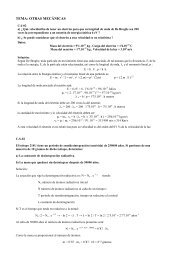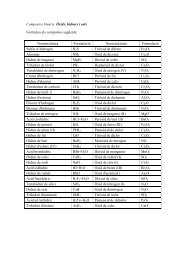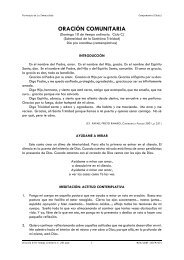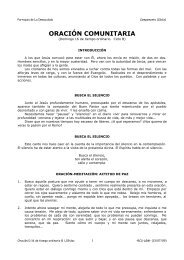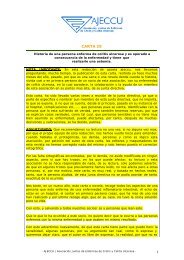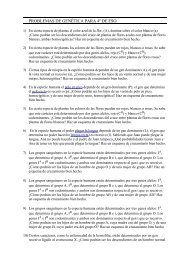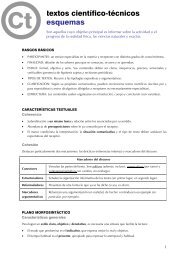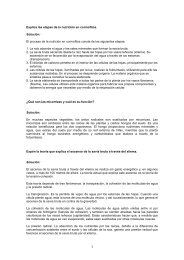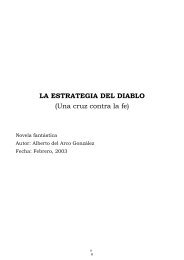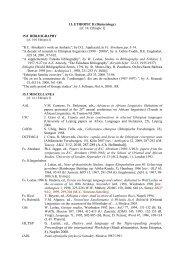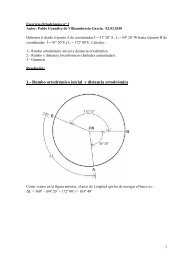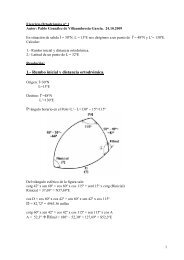BIB-SEM.6HB-dial _2010 - Telefonica.net
BIB-SEM.6HB-dial _2010 - Telefonica.net
BIB-SEM.6HB-dial _2010 - Telefonica.net
You also want an ePaper? Increase the reach of your titles
YUMPU automatically turns print PDFs into web optimized ePapers that Google loves.
J.A. Hackett, “Hebrew (Biblical and Epigraphic)”, in BBHBH. pp. 139-156.<br />
A.M. Honeyman, “The Syntax of the Gezer Calender”, JRAS 1953, 53-58.<br />
H. Irsigler: “Grosssatzformen im Althebräischen und die syntaktische Struktur der Inschrift des<br />
Königs Mescha von Moab”, in SynTex, pp. 81-121.<br />
A. Lemaire, “L’épigraphie paléo-hébraïque et la Bible”, in VTS 29 (Congress Volume :<br />
Göttingen 1977), pp. 165-176.<br />
A. Lemaire, P. Vernus, “L’origine égyptienne du signe x des poids incrits de l’époque royale<br />
israélite”, Semitica 28, 1978, 53-58.<br />
M.D. McLean, The use and development of Palaeo-Hebrew in the Hellenistic and Roman<br />
periods, Diss. Harvard Univ. 1982 [DAb 43/5, 1982, 1525-A].<br />
A.R. Millard, “‘Scriptio continua’ in early Hebrew: Ancient practice or modern surmise?”, JSS<br />
15, 1970, 3-15.<br />
H.-P. Müller, “Kolloquialsprache und Volksreligion in den Inschriften von Kuntillet c AÒrud und<br />
ïirbet el-Qom”, ZAH 5, 1992,15-51.<br />
G.A. Rendsburg, “The Siloam Tunnel Inscription: Historical and Linguistic Perspectives”, IEJ<br />
60, <strong>2010</strong>, 188-203.<br />
J. Renz, W. Röllig, Handbuch der althebräischen Epigraphik. B. II/2. Althebräische<br />
Morphologie, Darmstadt 2003.<br />
G.B. Sarfatti, “Hebrew inscriptions of the First Temple Period: a survey and some linguistic<br />
comments”, Maarav 3, 1982, 55-83.<br />
S. Segert, “Die Sprache der moabitischen Königsinschrift”, AO 29, 1961, 197-267.<br />
J. Stökl, “Kings, Heroes, Gods. The History of the Translation of the term ’r’l dwdh in Line<br />
Twelve of the Mešac-Stele”, KUSATU 8-9, 2008, 135-162.<br />
H. van de Parunak, “The orthography of the Arad ostraca”, BASOR, 230, 1978, 25-31.<br />
Sh. Yeivin, “An ostracon from Tel Arad exhibiting a combination of two scripts”, JEA 55,<br />
1969, 98-102 [interpreted as Eg. in Heb. script].<br />
I. Young, “The language of the judicial plea from Mesad Hashavyahu”, PEQ 122, 1990, 56-59.<br />
Z. Zevit, Matres lectionis in Ancient Hebrew epigraphs (American Schools of Oriental<br />
Research, Monograph Series 5), Cambridge MA 1980 [rev.: JES 42, 1983, 163-165 (P.J.<br />
Bruton); CBQ 44, 1982, 503-504 (D. Pardee); IEJ 33, 1983, 139-140 (J. Naveh); JSL 10,<br />
1982, 99-100 (F.C. Fensham); JBL 102, 1983, 629-634 A.F. Rainey); BZ 28, 1984, 131-133<br />
(W. Gross); JAOS 104/2, 1984, 374-375 (J. Barr); JBL 102, 1983, 629-634 A.F. Rainey);<br />
BZ 28/1, 1984, 131-133 (W. Gross); JAOS 104, 1984, 374-375 (J. Barr)].<br />
6B.1.2 Lexicography<br />
W.J. Adams, An investigation into the diachronic distribution of morphological forms and<br />
semantic features of extra-Biblical Hebrew sources (Diss. Univ. of Utah), Salt Lake City UT<br />
1987 [DAI 48/12, 1988, 3099-A].<br />
K. Cathcart, “Trkb qmú in the Arad ostracon and Biblical Hebrew rekeb upper millstone”, VT<br />
19, 1969, 121-123.<br />
Ch. Cohen, “Studies in extra-Biblical Hebrew inscriptions I. The semantic range and usage of the<br />
terms c mh and spúh”, Shnaton 5-6, 1978-79, xxv-liii.<br />
D. Diringer, S.P. Brock, “Words and meanings in early Hebrew inscriptions”, in Fs. Thomas,<br />
pp. 39-45.<br />
M. Heltzer, M. Ohana, The extra-biblical tradition of Hebrew personal names (from the First<br />
Temple Period to the end of the Talmudic Period) (Studies in the Hist. of the Jewish People<br />
and the Land of Israel, Monograph Series 2), Haifa 1978 [rev.: RB 88, 1981, 270-272 (E.<br />
Puech); StIr 20, 1981, 235-238 (F. Israel); Syria 57, 1980 (1983), 331-333 (A. Caquot);<br />
AIO 42, 1982, 165 (G. Garbini); WO 13, 1982, 168-172 (R. Zadok)].<br />
R.S. Hess, “Personal Names in Cuneiform Texts from Middle Bronze Age Palestine”, in Fs.<br />
Wyatt, pp. 153-161 (Hazor, Shechem, Hebron).<br />
W. Horbury: “A personal name in a jar-inscription in Hebrew characters from Alexandria”, VT<br />
44/I, 1994, 103-107.<br />
2




